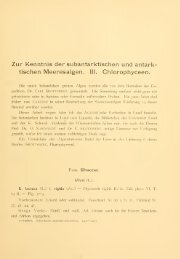Download PDF
Download PDF
Download PDF
Create successful ePaper yourself
Turn your PDF publications into a flip-book with our unique Google optimized e-Paper software.
112 ZYGNEMATACEAE<br />
90. MoucEOTiA TROPICA (W. & G. S. Wcst) Transcau 1926. Ohio<br />
Jour. Sci. 26, p. 325, PL 7, Fig. 112.<br />
Vegetative cells 6-7/1 x 36-56/1; chromatophore with 2 pyrenoids;<br />
zygospores unknown; aplanospores obliquely globose with projecting<br />
mammillate solid processes, wall yellow-brown, scrobiculate, 27-28/1 x<br />
27-29/1, with the processes 42-46/1 in length. (PI. XIX, Fig. 21.)<br />
Africa, Angola.<br />
91. MouGEOTiA MiAMiANA Transcau 1934. Trans. Amer. Micros.<br />
Soc. 53, p. 222, PL 19, Figs. 41-42.<br />
Vegetative cells 6-^.1 ti x 60-130/1; chromatophores with 2-6 pyre-<br />
noids; zygospores unknown; aplanospores formed in the middle of<br />
straight or slightly angled cells; outer sporangium wall covered at all<br />
stages by a pectic layer; aplanospores globose to ovoid to ellipsoid with<br />
projections at either end; globose spores 18-20/t in diameter, ellipsoid<br />
spores 16-18/1 x 25-32/1; spore wall yellow, punctate. (PI. XIX, Figs.<br />
22-23.)<br />
United States: Oklahoma, Miami, August 14, 1932 (Taft Coll.).<br />
92. MouGEOTiA VENTRicosA (Wittrock) CoUins 1912. Tufts Col-<br />
lege Studies. 3, p. 76.<br />
Vegetative cells 6-9/1 x 100-140 /i; chromatophores with about 4<br />
pyrenoids in a single row; zygospores unknown; aplanospores obliquely<br />
ellipsoid to subglobose, 12-24/1 x 16-29/1; spore wall smooth, yellowbrown.<br />
(PI. XIX, Fig. 24.)<br />
United States: Reported from California, Michigan, and Pennsylvania.<br />
Have seen no specimens.<br />
Sweden; Latvia.<br />
93. MouGEOTiA PRONA Transcau 1926. Ohio Jour. Set. 26, p. 326,<br />
PL 7, Figs. 109-11. .<br />
Vegetative cells 8-12/1 x 60-1 40 (-280) /i; chromatophores 2 with<br />
the nucleus between, pyrenoids 4-6 in each; zygospores unknown;<br />
aplanospores obliquely ellipsoid with ends produced and truncate,<br />
20-24/1 X 5o-52(-6o) /i; spore wall faintly yellow, punctate, with<br />
rounded or retuse ends. (PI. XIX, Figs. 26-28.)<br />
United States: New York, High Hill, Long Island, growing in a road-<br />
side spring.<br />
During the formation of an aplanospore an enlargement of the middle<br />
portion of the cell develops. Simultaneously the protoplast begins to con-<br />
tract and the 2 chromatophores move into the enlargement, i on each side<br />
of the nucleus. The contracted protoplast is cut off from the 2 narrow parts<br />
of the sporogenous cell by cross walls. A little later the spore wall develops.<br />
Similar stages have been seen in other species of Mougcotia.




